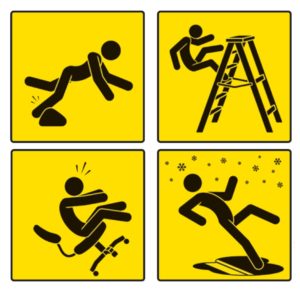Falls are the leading cause of injury accidents. Not all falls are from heights such as ladders or scaffolds. Most are falls from the same levels, caused by slipping or tripping.
There are three physical factors involved in slips, trips, and falls (e.g. friction, momentum, and gravity). They each play a role. Friction is the resistance between objects, momentum is affected by the speed and size of an object, and gravity is the force that pulls you toward the ground in a fall.
OSHA maintains general industry regulations on walking/working surfaces that guard against hazards including clutter, protruding nails, splinters, holes, loose boards, and wet conditions. Construction professionals deal with additional hazards from scaffolds, derricks, and cranes to name a few.
A. Slips
Slips are a loss of balance caused by too little friction between your feet and the surface you walk or work on. Loss of traction is the leading cause of workplace slips. This can be caused by constantly wet surfaces, spills, or weather hazards like ice and snow. Slips are more likely to occur when you hurry or run, wear the wrong kind of shoes, or don’t pay attention to where you’re walking. You can help avoid slips by following these safety precautions:
- Practice safe walking skills. Take short steps to keep your center of balance under you and point your feet slightly outward.
- Clean up spills right away or report them to the appropriate person. Even minor spills can be very hazardous.
- Don’t let grease accumulate at your job site.
- Be extra cautious on smooth surfaces such as new floors or floors that have been waxed. Take the weather into consideration, especially during winter and rainy conditions.
B. Trips
Trips occur whenever your foot hits an object and you are moving with enough momentum to be thrown off balance. Trips are more likely to happen when you are in a hurry and don’t pay attention to where you’re going. Remember these rules to avoid tripping:
- Make sure you can see where you’re going. Carry only loads that you can see over.
- Keep work areas well lit. Use a flashlight or extension light to make your walking area visible in dark areas.
- Make sure that your job site is clean. Store materials and tools in cabinets or assigned storage areas.
- Keep doors and drawers of cabinets and workbenches closed.
- Arrange equipment so that it doesn’t interfere with walkways or pedestrian traffic in your area.
- Extension or power tool cords can be dangerous tripping hazards. Working areas must be kept clear of them. Tape them to wall supports or arrange them so they won’t be in the way of other workers.
- Eliminate “loose footing” hazards on stairs, steps, and floors.
- Place barricades around equipment and wet surfaces.
- Store gangplanks and ramps properly.
C. Falls
Falls occur whenever you move too far off your center of balance. To avoid falls consider the following measures:
- Don’t jump. Lower yourself from trucks or work stages and watch your footing.
- Check the lighting. Make sure work sites are well lit.
- Watch for stairs or handrails that are loose or broken.
- Keep passageways and aisles clear of clutter.
- Wear shoes with appropriate non-skid soles.
- When walking on slippery areas or sloped floors surfaces such as ramps, go slowly and take small steps.
D. Training Tips
List the jobs or duties workers might perform at your company where slips, trips, and falls may occur, and methods to avoid injury Review safety requirements for footwear, PPE, fall safety, etc. Report any hazardous conditions immediately.
Source: ABM | ThinkSafe: People. Materials. Environment